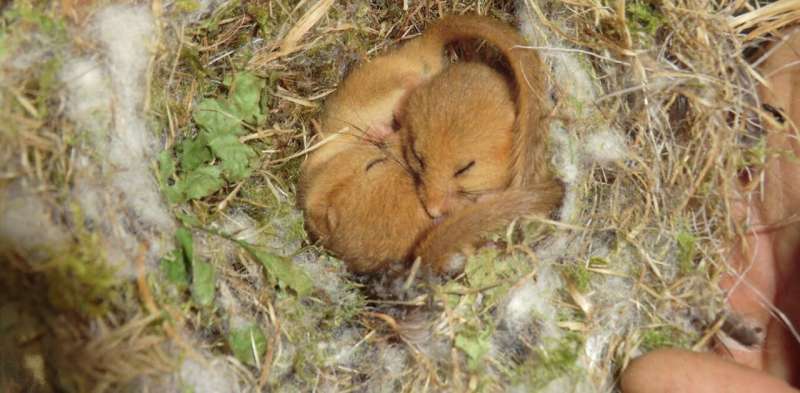This article has been reviewed according to Science X's editorial process and policies. Editors have highlighted the following attributes while ensuring the content's credibility:
fact-checked
trusted source
written by researcher(s)
proofread
Dormice are declining but current nest surveys don't tell the real story

British dormice have declined by a shocking 70% between 2000 and 2022, according to the latest report by the national dormouse monitoring program. But my research indicates that this decline might not be that catastrophic.
Dormice are small mammals that spend the late spring and summer mostly in the tree canopy, then hibernating at ground level when the weather gets cold. In order to know how best to protect them, we need more accurate statistics about their whereabouts, habits and survival rates.
For more than a decade, I have studied the effectiveness of dormouse monitoring. My recently published research questions the effectiveness of the standard survey technique that checks artificial nest boxes or tubes placed at 1.4m from the ground to see if dormice are using them.
Accurate determination of whether dormice are present on a site has ecological, legal and practical significance, so reliable and accurate survey methods are important.
Dormice are of particular interest not just to scientists from a biodiversity perspective, but also commercially, for example, to property developers as they are highly protected.
When any activity is considered on a site with potentially suitable habitat, dormouse surveys are required to establish whether they are present to avoid the risk of killing, injuring or disturbing them or damaging their breeding sites and resting places. There are several cases in the last few years where prosecution has resulted in heavy fines of up to £100,000.
If dormice are present, then the nature or timing of building work may need to be modified to comply with legislation. A license from government authorities such as Natural England or Natural Resources Wales is required for any activity that may affect dormice—that includes ecological surveys for woodland management and property development.
Together with my team of ecology researchers and students, I placed artificial nest boxes at different heights on trees and on isolated posts on two woodland sites in Kent. The boxes on posts could only be reached by dormice coming to the ground and traveling across the woodland floor.
We checked the boxes regularly over several seasons and found that boxes in all three positions were used. If boxes had only been placed in the standard position 1.4 m above ground, following current survey guidelines, significantly fewer dormice would have been detected. Dormice also regularly used the isolated boxes supporting the findings of others that dormice don't only live in trees as previously thought.
Interestingly, there was a decline in use of the boxes over the years of the project, something we had observed during previous long-term dormouse monitoring projects.
This drop off is the basis of the claim that dormice are in serious decline and, while this may well be true as habitat loss and climate change are undoubtedly affecting dormice, it is important to remember the dormice were obviously present before the boxes were installed.
It is possible that boxes were initially explored and used as novel features but that the dormice then returned to their previous nesting sites. A further factor may be the increased presence of parasites, particularly when boxes are also used by birds.
On-the-ground detection
Our results suggest that current survey and monitoring guidelines for dormice need to be reviewed and that dormice might not be declining quite as dramatically as has been suggested. Boxes in the tree canopy would be likely to yield more accurate data, but the cost would make it unlikely to be viable. And the issue of whether the boxes would be used for more than a few seasons remains.
Dormice hibernate in winter at ground level. There would be many advantages of a method based on this—not least that it would be less invasive, reducing the ethical and welfare concerns about regularly disturbing potentially breeding dormice. We've been working with the company Paws for Conservation to test the feasibility of using highly trained dogs to detect hibernating dormice, under a specific research license.
Using reward-based training, detection dogs can be trained to locate dormice, while ignoring all other small mammals likely to be encountered nearby. A cold winter that provides ideal hibernation conditions for dormice will give us the chance to test this promising technique under field conditions.
But it's not just about dormice—we need reliable methods to provide robust data so we can evaluate conservation actions to make sure monitoring techniques are delivering the best possible results for all species.
Science thrives on debate, and conservationists need to be open to opportunities for improvement. We have a responsibility to do the best we can, not just for specific animals but for our wider environment.
Provided by The Conversation
This article is republished from The Conversation under a Creative Commons license. Read the original article.![]()




















